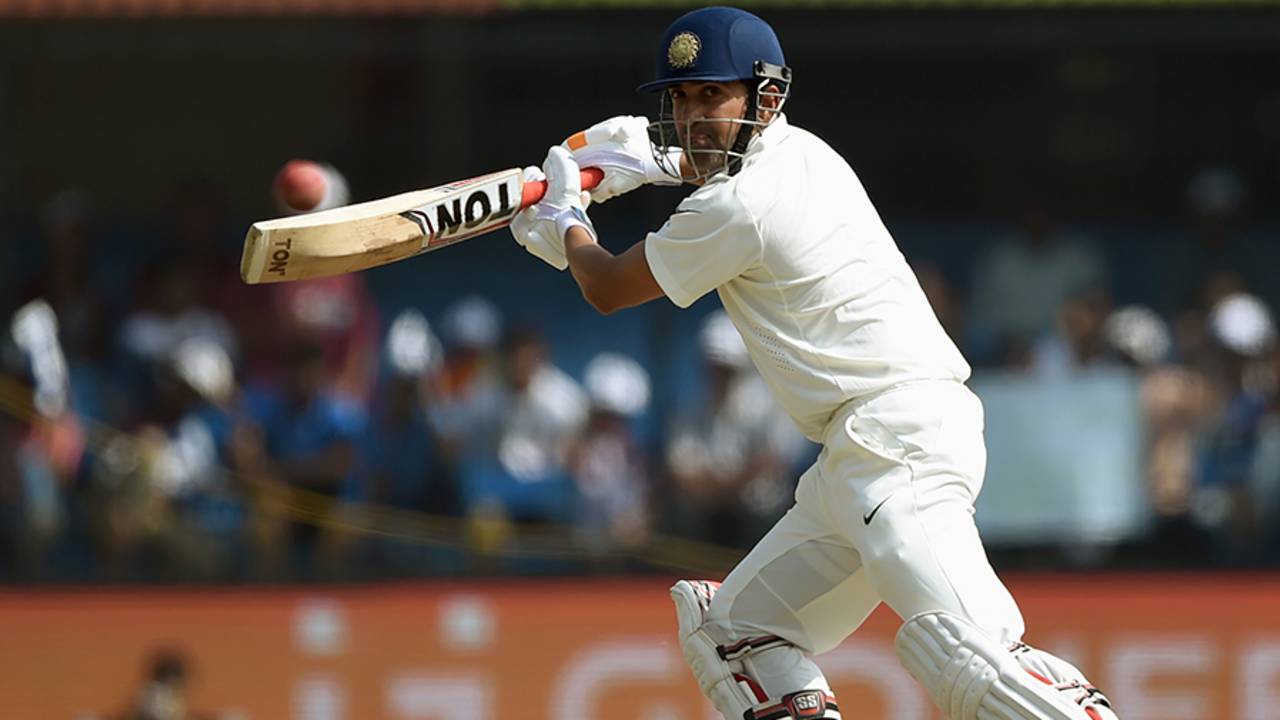From Tests to T20s: Five Gautam Gambhir classics
Remembering five knocks by the left-hander who announced his retirement from all forms of cricket on Tuesday
Ankur Dhawan
05-Dec-2018
Gautam Gambhir steers the ball on to the off side • AFP
India's parched run in New Zealand dated back to 1968 when, on their inaugural tour, MAK Patudi led them to a series win. Forty-one years later, under MS Dhoni, India found themselves in the ascendancy after the first Test in Hamilton, something that had not happened since 1976. But it started going pear-shaped in Napier, as India lost Dhoni due to a back spasm and stand-in captain Virender Sehwag lost a bad toss on a placid pitch. Counter-attacking hundreds from Ross Taylor and Jesse Ryder meant India were up against a mammoth total of 619.
Things did not go as planned with the bat as India collapsed from 246 for 4 to 305 all out, resulting in them following-on. At stumps on day three, India were 47 for 1, with Gautam Gambhir and Rahul Dravid at the crease and another 180 overs to negotiate. Time and deliveries consumed carried more valuable price tags than runs, and Gambhir, during his 137, ate up 437 deliveries, more than 40 percent of the total balls India needed to bat to save the Test and ticked off 642 minutes. He was finally out lbw to Jeetan Patel, but by then India were within sniffing distance of a draw, which helped them stay ahead in the series, and eventually win it 1-0 following another draw in Wellington.
Chasing the World Cup dream since clinching the crown in 1983, India were set 275 in the final in Mumbai by Sri Lanka. India needed to beat not just Sri Lanka but also history, as no team had won a final at home or chased a target as big or won after someone from the opposition had struck a hundred. After Mahela Jayawardene's unbeaten 103, India were rocked in the first over of the chase as Lasith Malinga pinned Sehwag lbw off the second ball, before stunning the raucous crowd into silence with the wicket of Sachin Tendulkar.
That left Gambhir in the company of a 22-year old Virat Kohli and he absorbed pressure like a sponge. He added 83 with Kohli to put India back on course, before adding 109 with MS Dhoni, after the captain famously promoted himself. Having brought India within touching distance of the win, Gambhir fell for 97 as he attempted to hit Thisara Perera over the top. But the 97 had done the job that Jayawardene's hundred could not as India won the World Cup after 28 years.
Four years earlier, post India's ignominious first-round exit in the 2007 World Cup, a young team was picked under a young Dhoni, for the inaugural World T20 in South Africa. India rode to the final on the back of Yuvraj Singh's brilliance, electric fielding, but also Gambhir's inconspicuous consistency at the top of the order. He continued his prolific run in the final against Pakistan, this time in the absence of regular opener Sehwag, who was out due to injury. As wickets tumbled around him, he not only held fort till the 18th over but got his 75 at a good clip, to give India a total to bowl at. He finished as the highest run-getter in the tournament and India lifted the trophy after the bowlers secured a wafer-thin five-run win.
Having found form in the second innings at Centurion, Gambhir missed the second Test won by India in Durban due to injury. When he returned at Newlands for the decider, India were two down in the blink of an eye in response to South Africa's 362, and the duel between Tendulkar and Dale Steyn had taken centre stage. Gambhir copped his fair share of hostility but reinforced his capacity to pull India out of trouble with a courageous 93. In the second innings he found himself in familiar territory, needing to bat time and save a Test that Jacques Kallis had put beyond India. Yet again Gambhir displayed a willingness to take blows on the body on an inconsistent pitch and an indomitable defence, as he consumed 184 balls for a gritty 64 that ensured a draw, and thereby a drawn series.
Gambhir took over as Kolkata Knight Riders captain in 2011, as part of wholesale changes made to improve their otherwise ordinary record in the tournament. His first year in charge saw KKR reach the play-offs for the first time but they exited after losing the eliminator to Mumbai Indians. The following year started poorly, as KKR lost their first two matches. It was in Bengaluru against RCB that KKR began their ascent to the top and it was Gambhir who laid the foundation. His 39-ball 64, that included nine fours and a six proved vital even as the middle-order collapsed, as KKR scored 165 and defended it by 42 runs to secure their first victory of a season they went on to win.
